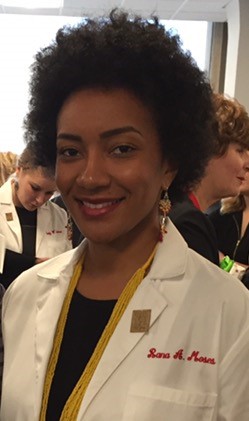Simplified Chronic Wound Scoring Using the Modified TIME-H System
June 30, 2016
Temple University School of Podiatric Medicine Journal Review Club
Editor's note: This post is part of the Temple University School of Podiatric Medicine (TUSPM) journal review club blog series. In each blog post, a TUSPM student will review a journal article relevant to wound management and related topics and provide their evaluation of the clinical research therein.
Article title: Modified TIME-H: A Simplified Scoring System for Chronic Wound Management.
Authors: S. Sinha, MEd, MS, FRACS; B. Free, RN, BN; K. Lim, MBBS.
Journal name and issue: Journal of Wound Care. September 2015. Vol. 24(9) (pages 415-419).
Reviewed by: Rana Moses, Class of 2018, Temple University School of Podiatric Medicine.
A chronic wound is best defined as a wound that neglects to complete the standard stages of wound healing in a timely fashion. Typically, these wounds remain unhealed for at least three months. In order to accurately determine the wound healing prognosis and the appropriate treatment, it is important to develop a system that is inclusive of both the assessment of the wound and the patient's overall health. TIME (Tissue, Inflammation/Infection, Moisture, Edge/Epithelialization) was a method originally used to promote chronic wound healing. However, this method was negligent in defining a prognosis and predicting wound healing potential.
TIME-H was eventually proposed, and included a Healing score (H) that would be derived based on wound condition, patient's general health and any present comorbidities. The healing score would serve to indicate expected wound healing time, and would help to design a patient centered treatment regimen. TIME-H proved to have certain limitations and errors that included inter-rater variability/subjectivity and the over-scoring of the total healing score, thus the results were not reliable. Modified TIME-H scoring system was then developed and took into consideration the subjective assessment, additive nature of comorbidity assessment, reduction of TIME assessment from four categories to three, and elimination of the 'absence of contamination' category. This study aims to analyze the feasibility and reliability of the Modified TIME-H score in chronic wound healing.
Methods
This is a prospective study that was conducted at the Royal Hobart Hospital Outpatient Wound Clinic (OWC) in Tasmania, Australia. Wound management was conducted on a weekly basis over a nine month period by one surgeon and three nurses. Additional support was provided by community nurses who provided follow up wound care services outside of the wound clinic. Patients were assessed for inclusion criteria which included presence of a chronic wound, willingness to attend the OWC for follow up, required any surgical interventions to assist in wound healing, or died before wound healing. Modified TIME-H was calculated with scores ranging from 0-2 for each four inclusion criteria, with a total possible score of 8. The patients were then further categorized into groups A (absence of conditions) and B (presence of any or all conditions). Reliability was tested by the surgeon and nurses, who independently score the wound. The patient's score was then recorded into their medical record and appropriate treatment was rendered. Each follow up visit to OWC resulted in the wound being remeasured, reassessed and given an updated Modified TIME-H score. The patient would follow up until there was complete wound healing or until the study ended.
Results
The study originally enrolled 58 patients but 12 were eventually excluded. Of the 46 patients, 24 were male and the median age was 76 years old. The wound types included venous ulcers (33 patients), pressure ulcers (3 patients), arterial ulcers (2 patients) and ulcers of mixed etiology (8 patients). The duration of all the wounds prior to the study have been reported to have a median presence of 12 months. Median wound size was 10.0cm2 with a median score of 4.0 on Modified TIME-H scoring system. Patients received a median of 3.3 months of OWC intervention. Wound healing was established in 16 patients after 2.9 months of treatment, and wounds did not heal in 30 patients after 3.4 months of treatment. Complete healing occurred in 3 out of 4 patients in the certain healing category, 10 out of 25 in the uncertain healing category, and 3 out of 17 in the difficult healing category. Patients allocated to the certain healing category were more likely to achieve complete wound healing.
Discussion
Scoring wounds with the Modified TIME-H scoring system proved to have a higher proportion of patients in the certain healing category achieve complete wound healing with a higher reduction in wound size, with shorter OWC intervention. The results suggests that previous ambiguities are less likely to occur using the Modified TIME-H scoring system, and that this system could be a useful tool.
Conclusion
The findings show that Modified TIME-H scoring system is practical and systematic in providing appropriate and accurate wound prognostication and treatment leading to better outcomes. Limitations to this study include small sample size and a short duration of study. In addition, comparing the original TIME-H scoring system to the Modified TIME-H scoring system might have proved to be beneficial.
About the Authors:
Rana Moses is a second year Podiatric medical student at Temple University School of Podiatric Medicine (TUSPM) in Philadelphia, Pennsylvania. She graduated from Rutgers University in New Brunswick, NJ in 2011 with a Bachelor of Arts in Biological Sciences. As an undergraduate, Rana was very active in numerous clubs and volunteer activities.
Dr. James McGuire is the director of the Leonard S. Abrams Center for Advanced Wound Healing and an associate professor of the Department of Podiatric Medicine and Orthopedics at the Temple University School of Podiatric Medicine in Philadelphia.
The views and opinions expressed in this content are solely those of the contributor, and do not represent the views of WoundSource, HMP Global, its affiliates, or subsidiary companies.








